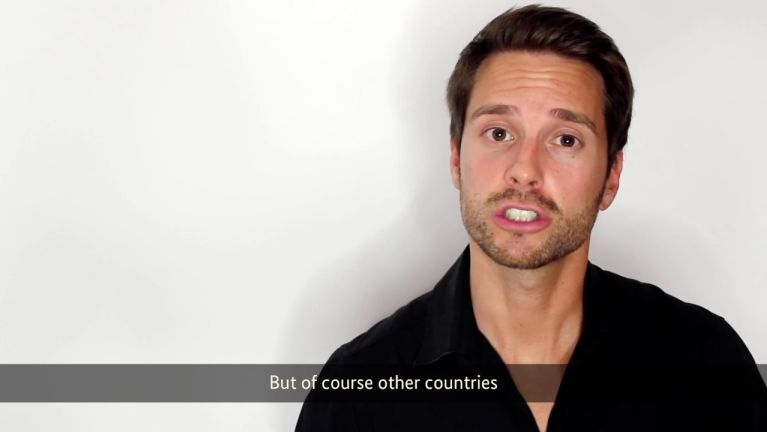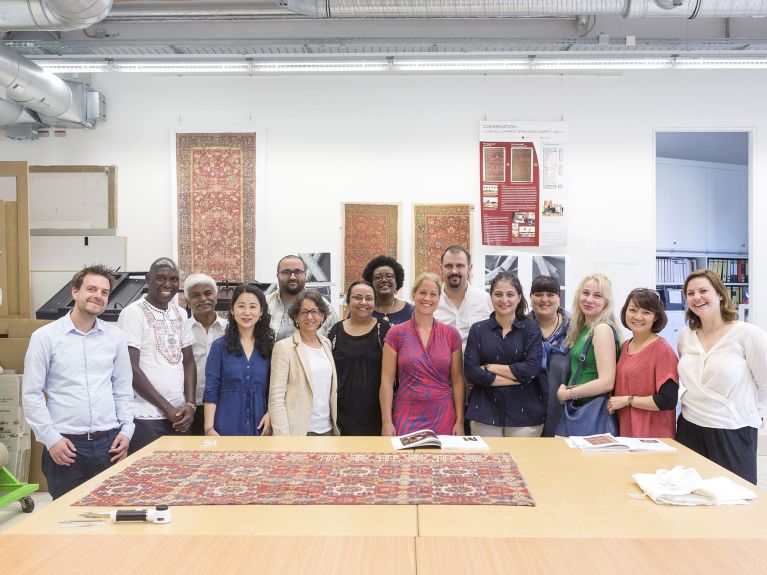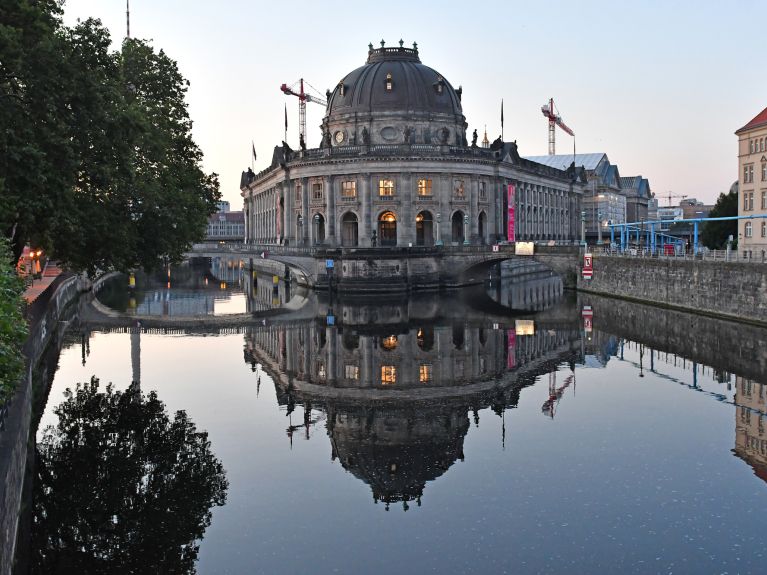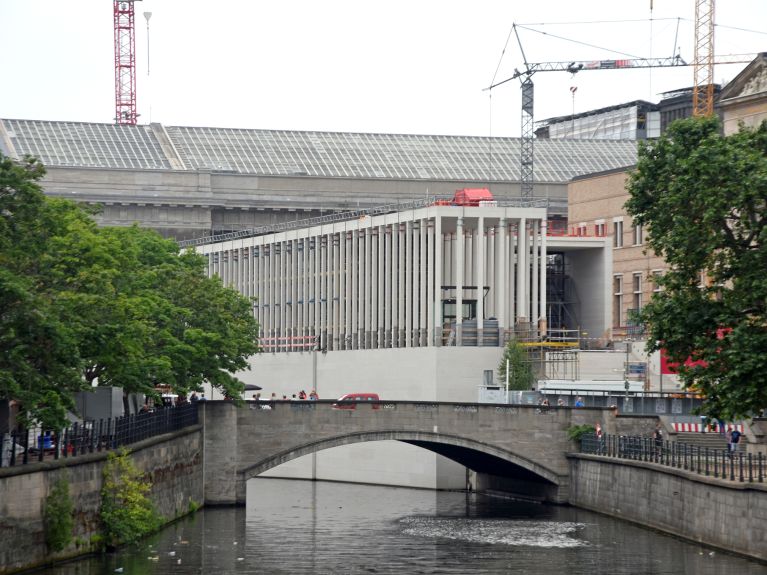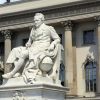In the world’s workshop
Every artwork tells a story. International guests found out how Germany helps make these stories heard on a visit in Berlin.
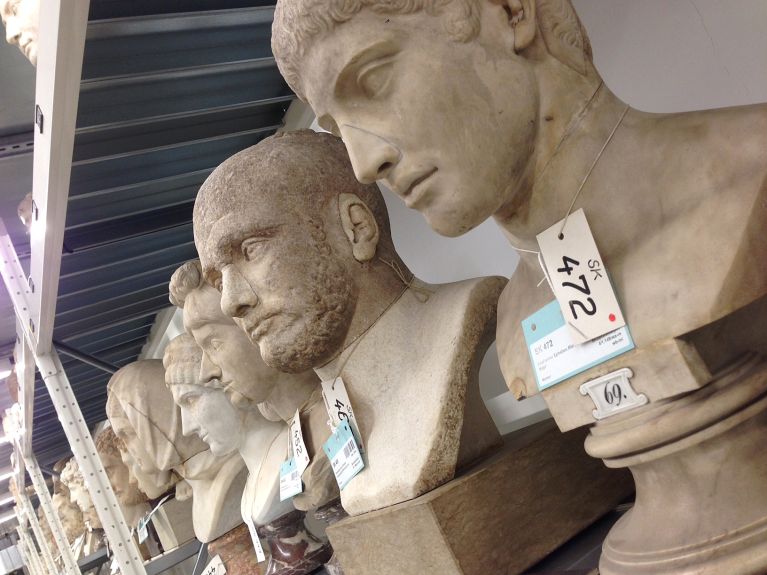
Anna Beselin is looking forward to tomorrow – it is not often that she has an appointment like this: The restorer at the Berlin Museum für Islamische Kunst (Museum of Islamic Art) is set to travel to Munich to meet the owner of the fragment of an ancient rug. The woman wishes to leave it in the museum’s care. The institution already owns another piece of the rug – lying in front of Beselin on the table in the restoration workshop. Graphic, almost modern patterns adorn the rug. It comes from the Caucasus, the art historian can see from the knotting technique, among other things. She estimates that it was made in the mid-17th century.
Beselin shows which of the rug’s many damaged areas she wishes to restore, and which she will leave as they are, in order to not change the overall impression too much. “All our patients require individual treatment – each rug has its own story to tell,” the expert for historical textile works explains to her visitors, who have gathered around the table. During their one-week trip, the guests of the Visitors Programme of the Federal Republic of Germany learn about Germany’s commitment to cultural preservation. On this day in the workshops of the Staatliche Museen zu Berlin, the Berlin State Museums, they see a piece of fabric from an Egyptian tomb, stone coffins from Etruscan times and much more besides.
Internationally sought-after expertise
The Staatliche Museen zu Berlin owns around 5.3 million objects. The lion’s share of them is located here in the stores and workshops. A smaller portion is on show in the 15 museums spread throughout the city. Nikita Korytin, Head of the Ekaterinburg Museum of Fine Arts, is impressed, but also sceptical regarding the many exhibition venues. “Large structures like this are not always effective,” the expert from Russia notes. “That’s true”, says Christina Haak, Deputy Director-General of the Staatliche Museen. “But in our case the tasks cannot be separated. Diversity is our strength.” As such, visitor magnets like the Pergamonmuseum, with its over one million visitors per year, ensure that smaller museums like the Kupferstichkabinett (Museum of Prints and Drawings) and Kunstgewerbemuseum (Museum of Decorative Arts) also have a future.
Smuggling and illegal excavations destroy the heritage of humankind.
Moreover, the Staatliche Museen and the Stiftung Preußischer Kulturbesitz (Prussian Cultural Heritage Foundation), under whose auspices it operates, offer such broad and diverse expertise that others also benefit from it. Indeed, in addition to the maintenance and exhibition of its own collection, its tasks also include cultural preservation worldwide and combatting smuggling and illegal excavations. “Our research methods are internationally sought-after,” says Haak. German experts hold workshops, for instance, in China and the Arab world. They are currently developing a database for destroyed and endangered cultural heritage in Syria. “Smuggling and illegal excavations destroy the heritage of humankind,” notes Haak.
Clear rules for buying art
The standards are correspondingly high when the Berlin museums acquire or borrow artworks. “We have clear rules and the provenance of an object must be clear,” states Haak. “We go to great lengths to shed light on the origin of the works. If we find out that the background is unclear, we say no.” Munaa Alfazea nods. The cultural journalist for the Kuwait Times thinks that Germany should play an important role worldwide in the preservation of cultural heritage. “Germany should lead the way in this matter.”
Dieses YouTube-Video kann in einem neuen Tab abgespielt werden
YouTube öffnenThird party content
We use YouTube to embed content that may collect data about your activity. Please review the details and accept the service to see this content.
Open consent formChristina Haak points to the significance of partnerships, for instance with other European countries and with UNESCO. When visiting Berlin’s Museum Island in the afternoon the guests see how important this cooperation is in their own country too. For the Museum Island, with its five exhibition venues, is changing. Ralf Nitschke, responsible for construction planning at the Staatliche Museen, outlines the Museum Island Master Plan on a guided tour of the area. It envisages three main changes: A new visitor centre is being built at the entrance to the Museum Island, the James-Simon-Galerie (James Simon Gallery), designed by British architect David Chipperfield. The cranes are also up and running at the Pergamonmuseum, building a fourth wing. The final project to be completed will be the “Archaeological Promenade” – a subterranean walkway linking four of the five museums. The estimated completion date of all construction work is 2040.
UNESCO involved
Some of the guests are amazed that so much construction work is underway on a site protected by UNESCO. “A new building in a World Cultural Heritage ensemble – how is that possible?” asks Kosovan urban planner Enes Toska with a view to the visitor centre. Taimur Islam, who has launched an initiative to protect cultural heritage in Bangladesh, even postulates that UNESCO is less strict with Germany than with other countries. He complains about double standards.
Ralf Nitschke enlightens them by explaining what led to the construction of the James-Simon-Galerie. Indeed, UNESCO rejected the first design by Frank O. Gehry. For the second attempt the designers sought more involvement from UNESCO; among other things the organization was represented in the jury. All parties were satisfied with the result. Chipperfield’s building adopts features from the older buildings and yet is still modern. And a building on this spot is not actually new, says Nitschke. The “Packhof”, a customs building and warehouse, stood there until the 1930s. So all of this is a natural development, according to the planner. The Museum Island was created and grew over 100 years. “Now the story is continuing.”
